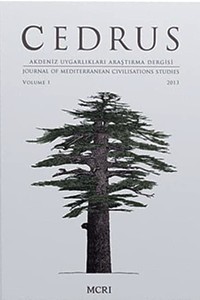Attouda Antik Kenti Dor Başlıkları
Bu çalışmada Denizli ili, Sarayköy ilçesi, Hisar Mahallesi sınırlarında yer alan Attouda antik kentinde ilk kez 2021 yılında gerçekleştirilen yüzey araştırmaları sırasında tespit edilen 11 adet Dor sütun başlığı ele alınmıştır. Dor başlıklarının birçoğu, Attouda antik kentinin üzerine kurulan Hisar Köyü’ne ait konutların bahçelerinde duvar sınırlayıcısı veya merdiven basamağı gibi farklı amaçlarla devşirme olarak kullanım görmüştür. Bununla birlikte çalışmanın konusu olan bu başlıklar farklı alanlarda dağıtılmış şekilde belgelenmiştir. Bu da blokların ikincil kullanıma bağlı olarak zaman içinde bulundukları yerden taşındığını, farklı alanlara dağıtıldığını göstermektedir. Tespit edilen Dor başlıklarından ikisi daha önceki bazı bilimsel çalışmalarda incelenmiş, diğer bloklar ise ilk kez bu çalışmada değerlendirilmiştir. Antik kentin Dor başlıklarının bütüncül olarak ilk kez ele alındığı bu çalışmada, Attouda antik kentinin Geç Hellenistik - Erken Roma İmparatorluk Dönemi’nde sahip olduğu mimari gelenek, üslup ve etkileşimin yönü üzerinde yeni tespitler yapılmıştır. Dor başlıkları ile ilgili bu yeni tespitler antik kentin mimari geleneğinin anlaşılabilmesi bakımından önem taşımaktadır. Çünkü antik kente ait yapıların büyük bir bölümü 1. Derece Arkeolojik Sit ve Kentsel Arkeolojik Sit Alanı olarak ilan edilen ve 143 adedi tescil edilen Hisar Köyü’ne ait konutların altında kalmıştır. Bu nedenle kentte tespit edilen mimari yapılara ait malzemeler, Attouda’nın antik dönem yapılaşması hakkında önemli bilgiler sağlayacak olmakla birlikte ilk kez tanıtılan bloklar malzemenin özgün değerini de göz önüne sermektedir.
Anahtar Kelimeler:
Karia, Phrygia, Attouda, Mimari, Dor Başlığı, Erken İmparatorluk Dönemi
Doric Capitals from Ancient City of Attouda
In this study, 11 Doric column capitals found in the ancient city of Attouda, located in the Hisar District of Sarayköy district of Denizli province, were discussed. The aforementioned Doric capitals were discovered for the first time during the surveys carried out in 2021. Most of these identified Doric capitals have been used as spolia, such as wall limiters and stair steps in the gardens of the houses belonging to the Hisar Village, built in the ancient city of Attouda. This situation shows that blocks were moved from their original places depending on the secondary use and distributed to different areas. Two of the Doric capitals have been examined in some previous scientific studies, and it is aimed to bring the other blocks to the literature for the first time with this work. In this study, in which the Doric capitals of the ancient city were handled holistically for the first time, new determinations were made on the architectural tradition, style, and direction of interaction that the ancient city of Attouda had during the Late Hellenistic–Early Roman Imperial Period. These new determinations about Doric capitals are essential in understanding the architectural tradition of the ancient city. Because most of the buildings belonging to the ancient city remained under the residences of Hisar Village, which was declared as a 1st Degree Archaeological Site and Urban Archaeological Site, and 143 of which were registered. For this reason, the materials belonging to the architectural structures found in the city will provide important information about the ancient construction of Attouda. The capitals introduced here for the first time reveal the value of the material.
Keywords:
Caria, Phrygia, Attouda, Ancient Architecture, Doric Capitals, Early Imperial Period,
___
- Alzinger W. 1974, Augusteische Architektur in Ephesos. Wien.
- Bohn R. 1885, Das Heiligtum der Athena Polias Nikephoros. AvP. II. Berlin.
- Buckler W. H. & Calder W. M. 1939, Monuments and Documents from Phrygia and Caria, Monumenta Asiae Minoris Antiqua VI. Manchester.
- Can B. et al. 2020, “Blaundos Antik Kenti 2018 Yılı (İlk Sezon) Çalışmaları”. KST 41/1, 393-409.
- Coulton J. J. 1979, “Doric Capitals: A Proportional Analysis”. The Annual of the British School at Athens 74, 81-153.
- Coulton J. J. 1982, “Oinoanda: The Doric Building (MK2)”. AnatSt 32, 45-59.
- de Bernardi Ferrero, D, 1988. Batı Anadolu’nun Eski Çağ Tiyatroları. Çev. E. Özbayoğlu. Ankara.
- Demirer Ü. & Sayın E. 2019, “Kibyra'dan Ekinusu İon Kymationlu Dor Başlıkları”. ANASAY 10, 43-59.
- Filges A. 2002, “Blaundos 2000”. AST 19/1, 263-270.
- Filges A. 2006, Blaundos. Berichte zur Erforschung einer Kleinstadt im lydisch-phrygischen Grenzgebiet. IstForsch 48. Tübingen.
- ISSN: 2147-8058
- Yayın Aralığı: Yıllık
- Başlangıç: 2013
- Yayıncı: Akdeniz Üniversitesi
Sayıdaki Diğer Makaleler
Porsuk-Zeyve Höyük Hellenistik Dönem Yerel Üretim ve Geleneksel Boya Bezemeli Seramikleri
Terrance Michael Patrick DUGGAN
Karia Stratonikeiası Teritoryumundan Bozukbağ Asklepios Heykelciği
Geç Orta Çağ Türk Dönemi’nde Manavgat Kalesi (1071-1453)
Lykia’dan Teke İline, Sedirden Ambara Antalya Ahşap Tahıl Ambarlarının Öyküsü
Gebiz Yıkık Camii Haziresindeki Mezar Taşları
Arykanda’dan Bir Masa Amphora Tipi (AF1) Üzerine Düşünceler
Cami İç Mekânlarında Tekerlekli Sandalye Uyumlu Abdest Alma Ünite Önerisi
